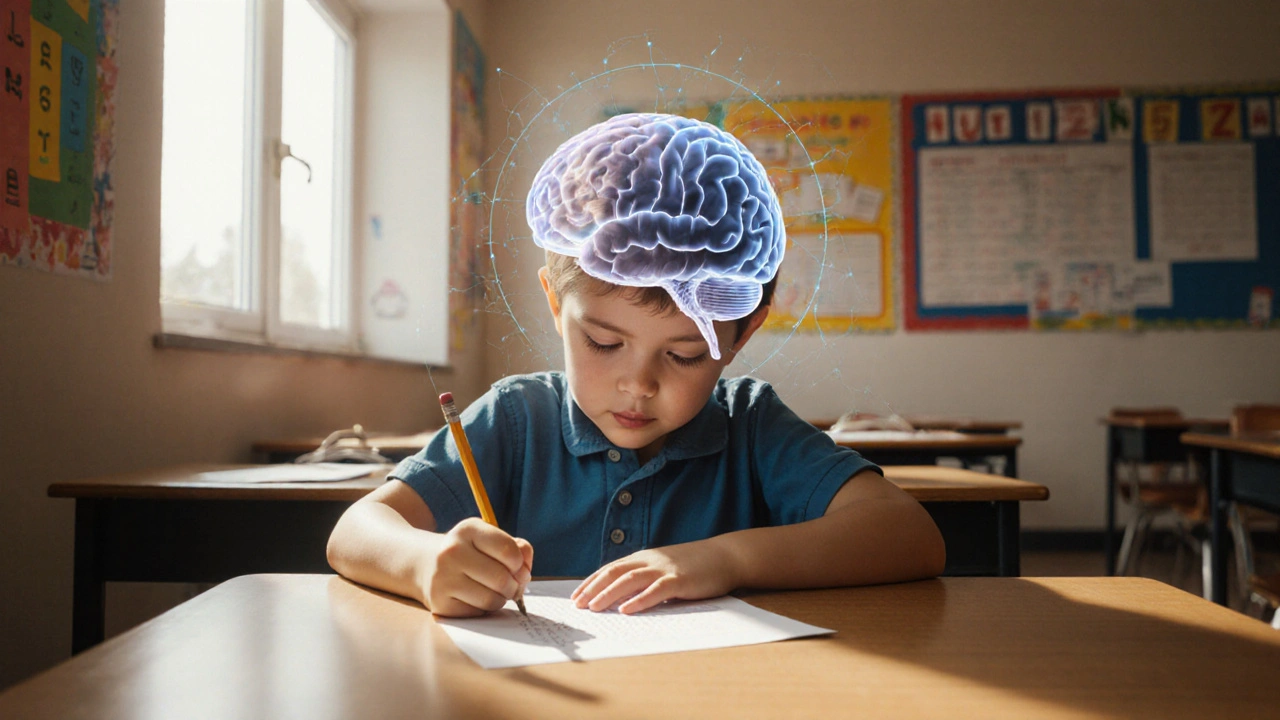How Poor Muscle Control Impacts Learning Disabilities

Learning Disability & Motor Control Risk Calculator
Ever wonder why some kids struggle with reading or math even though they seem bright and motivated? One often‑overlooked factor is poor muscle control a condition where the muscles responsible for fine and gross movements don’t coordinate efficiently. When the body can’t move smoothly, the brain also faces extra work, which can ripple into learning performance. This article breaks down the link, shows the signs to watch for, and offers practical steps you can take.
What Is Poor Muscle Control?
Poor muscle control refers to difficulties in coordinating voluntary muscle movements, affecting both fine motor tasks (like writing) and gross motor tasks (like running). Children with this issue may appear clumsy, have trouble buttoning shirts, or struggle to keep a pencil on the line. The underlying causes range from developmental coordination disorder (DCD) to sensory processing challenges.
Understanding Learning Disabilities
Learning disabilities are neurologically based processing problems that interfere with the acquisition of specific academic skills, such as reading (dyslexia), writing (dysgraphia), or mathematics (dyscalculia). They are not a reflection of intelligence; rather, they represent how the brain organizes, stores, and retrieves information. Because learning relies on a chain of sensory input, motor output, and cognitive processing, any break in that chain can exacerbate the difficulty.
How Motor Skills Connect to Learning
The brain’s motor and language centers sit side by side in the cortex. When a child’s fine motor skills precision movements involving small muscles, like those in the hands and fingers are weak, tasks such as copying notes or using a keyboard become labor‑intensive. That extra effort burns cognitive resources that could otherwise be used for comprehension.
Likewise, poor gross motor skills large‑muscle actions such as jumping, running, or balancing can affect classroom behavior. Kids who can’t sit still comfortably may appear inattentive, leading teachers to misinterpret the root cause.
One common diagnosis that bridges these domains is Developmental Coordination Disorder a neurodevelopmental condition marked by marked clumsiness and poor coordination that interferes with daily activities. Studies from 2022‑2024 estimate that about 30‑50% of children with DCD also meet criteria for a learning disability.
Evidence Linking Poor Muscle Control to Specific Learning Disabilities
- A 2023 longitudinal study of 1,200 school‑age children found that those scoring in the lowest 10% on a standardized motor‑control test were four times more likely to be diagnosed with dyslexia by third grade.
- Research published in the Journal of Pediatric Psychology (2024) showed that children with dysgraphia performed significantly worse on a grip‑strength assessment, indicating a clear fine‑motor component.
- Neuroimaging data reveal reduced connectivity between the cerebellum (the brain’s movement hub) and the left inferior frontal gyrus (a language‑processing area) in kids who struggle with both motor tasks and reading.
- Intervention trials where children received 12 weeks of targeted motor training reported an average 15% improvement in reading fluency, suggesting a causal relationship rather than mere correlation.

Signs Parents and Teachers Should Watch For
Look for patterns that tie movement to academic performance:
- Consistent difficulty holding a pencil, leading to illegible writing.
- Frequent dropping of objects, inability to tie shoes, or clumsiness on playground equipment.
- Reluctance or fatigue during tasks that require sustained hand use, such as cutting with scissors.
- Appearing tired or frustrated after handwriting assignments, even if the content is correct.
- Mixed results: bright oral explanations but poor written work, suggesting a motor bottleneck.
Strategies and Interventions
Addressing the issue early can prevent a cascade of academic setbacks. Here are evidence‑based approaches:
- Occupational therapy therapy focused on improving fine motor coordination, sensory integration, and functional daily‑living skills-typically 1‑2 sessions per week-has shown a 20% gain in handwriting speed after 8 weeks.
- In‑class “motor breaks”: short, guided activities (e.g., squeezing a stress ball, finger‑popping) that reset the nervous system and improve focus.
- Assistive technology: weighted pens, slant boards, or speech‑to‑text software reduce the physical strain of writing.
- Home exercises: activities like threading beads, building with LEGO, or playing musical instruments boost fine‑motor control while staying fun.
- Teacher accommodations: allow oral responses, provide printed copies of worksheets, or give extra time for written tasks.
When to Seek Professional Help
If you notice any of the following, it’s time to act:
- Motor difficulties persist beyond age 5 and interfere with school work.
- Academic progress stalls despite adequate instruction and effort.
- Teachers report that the child’s work quality drops dramatically when tasks require fine motor precision.
- Physical therapy or pediatric evaluation reveals low scores on standardized motor‑development assessments.
Start with a pediatrician referral to a developmental‑pediatrics specialist, who can coordinate assessments with occupational therapists and educational psychologists.
Comparison of Learning Disabilities and Their Association with Poor Muscle Control
| Learning Disability | Typical Motor‑Control Impact | Strength of Association |
|---|---|---|
| Dyslexia | Fine‑motor challenges in letter formation, occasional clumsiness | High |
| Dysgraphia | Significant fine‑motor deficits, poor grip strength | Very High |
| Dyscalculia | Moderate fine‑motor issues, often linked to spatial‑orientation problems | Medium |
| ADHD (with learning component) | Gross‑motor restlessness, difficulty sitting still | Medium‑High |
| Specific Language Impairment | Minimal motor impact, primarily oral‑language processing | Low |
Frequently Asked Questions
Can poor muscle control cause a learning disability, or is it just a side effect?
Research shows a bidirectional relationship. Weak motor skills can overload the brain’s processing capacity, making learning harder. At the same time, some neurological patterns that cause learning disabilities also affect motor coordination.
How early can we spot the link between motor issues and learning problems?
Signs often appear in preschool, especially during activities that require fine‑motor precision-like drawing shapes or using scissors. Early screening tools (e.g., the Movement ABC) can flag concerns before formal schooling begins.
Is occupational therapy the only effective treatment?
Occupational therapy is a cornerstone, but a multi‑disciplinary approach works best. Combining motor‑skill drills, classroom accommodations, and, when needed, speech or reading interventions yields the most robust gains.
Do adults benefit from the same interventions?
Absolutely. Adult neuro‑rehabilitation programs focus on functional tasks-typing, note‑taking, and using assistive devices-to improve both motor efficiency and academic/professional performance.
What’s a quick home activity to boost fine‑motor skills?
Try a daily 5‑minute “bead string” game: thread large wooden beads onto a shoelace. It strengthens finger dexterity, hand‑eye coordination, and concentration-all crucial for handwriting.

Bianca Fernández Rodríguez
October 4, 2025 AT 02:28Oh great, another knee‑jerk link between shaky hands and dyslexia. The article glosses over the massive body of work showing that cogntition drives motor skills, not the other way around. Guess we’re all just supposed to trust a handful of correlational studies.
Patrick Culliton
October 7, 2025 AT 13:48Seriously? Dismissing the whole motor‑control literature is lazy. If you actually read the 2023 longitudinal study, you’d see that motor deficits are a symptom, not the root cause.
Andrea Smith
October 11, 2025 AT 01:08While it is essential to acknowledge the interplay between motor and cognitive development, the article provides a commendable overview for parents seeking early indicators. Its tone remains balanced, and the suggested interventions are both evidence‑based and practical.
Gary O'Connor
October 14, 2025 AT 12:28yeah, i think the whole "motor break" thing is pretty chill. kids just need a lil breather, no big deal.
Justin Stanus
October 17, 2025 AT 23:48Reading this feels like wading through a pool of gloom. Every parent is left with the dread that their child’s future hinges on a single grip‑strength test.
Claire Mahony
October 21, 2025 AT 11:08While the tone is somewhat alarmist, the advice to consult a developmental‑pediatrics specialist is sound. It’s a measured recommendation amid the panic.
Andrea Jacobsen
October 24, 2025 AT 22:28I love how the article highlights simple home activities like bead‑stringing. Those little steps can make a world of difference without overwhelming families.
Andrew Irwin
October 28, 2025 AT 09:48Let’s keep the conversation constructive: combining occupational therapy with classroom accommodations tends to yield the best outcomes. Collaboration between parents, teachers, and therapists is key.
Jen R
October 31, 2025 AT 21:08Nice summary, but it’s basically what every pediatrician already says.
Joseph Kloss
November 4, 2025 AT 08:28One could argue that the article is a reductionist attempt to map a complex neurodevelopmental landscape onto a single variable: muscle control. While correlation does not imply causation, the literature cited often omits the mediating role of executive function, which some scholars contend is the true driver behind academic performance. Moreover, the piece glosses over the heterogeneity within disorders like dyslexia, where phonological processing deficits may exist independently of motor proficiency. In short, the narrative, though well‑intentioned, risks reinforcing a simplistic causal chain.
Anna Cappelletti
November 7, 2025 AT 19:48I really appreciate the thorough list of signs to watch for; it makes early screening much easier for parents. Also, the emphasis on neuroimaging studies adds credibility without being overly technical. If anyone is looking for additional resources, the American Occupational Therapy Association has downloadable checklists that align nicely with the article’s points.
Dylan Mitchell
November 11, 2025 AT 07:08Okay, first off, "grammer" is spelled wrong in the heading. Second, the article’s bullet points lack parallel structure – some end with periods, others don’t. This kind of inconsistency distracts from the otherwise solid content. Please proofread before publishing!
Elle Trent
November 14, 2025 AT 18:28The piece is a decent primer, but it leans heavily on jargon like "cerebellar connectivity" without explaining it for laypeople. A bit more plain‑language framing would make it truly accessible.
Jessica Gentle
November 18, 2025 AT 05:48First, it’s important to recognize that motor control and learning intersect at multiple neural hubs, including the cerebellum, basal ganglia, and prefrontal cortex. Second, recent meta‑analyses indicate that targeted fine‑motor interventions can improve not only handwriting speed but also reading fluency, likely due to reduced cognitive load during transcription tasks. Third, the article correctly points out that occupational therapy should be part of a multidisciplinary plan, yet it underemphasizes the role of school‑based occupational therapists who can integrate interventions directly into the classroom routine. Fourth, parents often wonder about home strategies; activities such as playing with Play‑Doh, building with interlocking bricks, or practicing piano scales can all enhance proprioceptive feedback and finger dexterity. Fifth, the suggestion to use weighted pens is useful, but research shows that the benefits are modest compared to systematic motor‑skill training over several weeks. Sixth, the risk‑calculator tool embedded in the article is a nice interactive element, but clinicians should treat its output as a screening aid rather than a diagnostic verdict. Seventh, when considering technology, speech‑to‑text software can relieve writing pressure, but it should be coupled with explicit instruction on organizing thoughts, otherwise the underlying language deficits remain unaddressed. Eighth, teachers can adopt simple classroom accommodations, such as providing pre‑printed worksheets or allowing oral presentations in place of written reports, which can mitigate the impact of motor delays on academic grading. Ninth, the article’s reference list is current, covering studies up to 2024, which should reassure readers about its evidence base. Tenth, for families with limited access to private therapy, community programs at public libraries often offer free fine‑motor workshops for children. Eleventh, it’s worth noting that early identification, ideally before age five, yields the greatest gains from intervention, as neural plasticity is at its peak. Twelfth, while the article mentions DCD, it could also discuss sensory integration disorder, which sometimes co‑occurs and requires a different therapeutic approach. Thirteenth, the relationship between gross‑motor restlessness and attentional challenges, as seen in ADHD, suggests that movement‑based classroom strategies (e.g., standing desks) may benefit a broader spectrum of learners. Fourteenth, parents should keep records of their child’s progress, documenting both motor milestones and academic scores, to provide objective data for clinicians. Finally, continuous collaboration among pediatricians, occupational therapists, educators, and families is the cornerstone of a successful support plan, ensuring that motor challenges do not become an unnecessary barrier to learning.